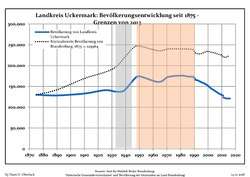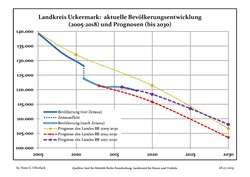Uckermark (district)
Uckermark (![]()
Uckermark | |
|---|---|
%26groups%3D_fc4859ae518b86686ddb9fb71d7a0d423c01e3b1.svg)
| |
| Country | Germany |
| State | Brandenburg |
| Capital | Prenzlau |
| Area | |
| • Total | 3,058.2 km2 (1,180.8 sq mi) |
| Population (31 December 2018)[1] | |
| • Total | 119,552 |
| • Density | 39/km2 (100/sq mi) |
| Time zone | UTC+01:00 (CET) |
| • Summer (DST) | UTC+02:00 (CEST) |
| Vehicle registration | UM |
| Website | http://www.uckermark.de |
Geography
The Uckermark is named after the Uecker river, which is a tributary of the Oder. The Oder River, forming the Polish border, bounds the district in the east. The district is characterised by 600 lakes and 2,800 km of rivers. Rare animals still live in the lakeland, such as ospreys, beavers and otters.
The western parts of the Lower Oder Valley National Park are located in the district.
History
The Uckermark was originally divided between the administrative units Uckerkreis and Stolpirischer Kreis. In 1817 as part of the Province of Brandenburg, a third district was created in the area, the district Angermünde, and the other two districts were renamed to Prenzlau and Templin. The current district Uckermark was created in 1993 by merging the previous districts Angermünde, Prenzlau and Templin, as well as the previously district-free city Schwedt.
Demography
 Development of Population since 1875 within the Current Boundaries (Blue Line: Population; Dotted Line: Comparison to Population Development of Brandenburg state; Grey Background: Time of Nazi rule; Red Background: Time of Communist rule)
Development of Population since 1875 within the Current Boundaries (Blue Line: Population; Dotted Line: Comparison to Population Development of Brandenburg state; Grey Background: Time of Nazi rule; Red Background: Time of Communist rule) Recent Population Development and Projections (Population Development before Census 2011 (blue line); Recent Population Development according to the Census in Germany in 2011 (blue bordered line); Official projections for 2005-2030 (yellow line); for 2014-2030 (red line); for 2017-2030 (scarlet line)
Recent Population Development and Projections (Population Development before Census 2011 (blue line); Recent Population Development according to the Census in Germany in 2011 (blue bordered line); Official projections for 2005-2030 (yellow line); for 2014-2030 (red line); for 2017-2030 (scarlet line)
|
|
|
Coat of arms
 |
The main feature of the coat of arms are the brick buildings of the district — the churches of Prenzlau and Angermünde. The city wall below recalls the many wars of the Middle Ages. The two circular windows in the church tower symbolizes the division into two districts before the reform of 1817, the three Gothic windows represent this division. On the city wall are two shields — one with the griffin of Pomerania, the other with the red eagle of Brandenburg. The wavy lines in the upper part represent the main rivers in the district, Oder, Randow, and Uecker. The yellow color of the background represents the agriculture of the district, as the Uckermark was the "granary" of Brandenburg. The coat of arms was created by Hans Benthin, and was officially granted on November 8, 1995. |
Towns and municipalities
| Amt-free towns | Ämter | |
|---|---|---|
|
|
4. Amt Gramzow | |
| 1seat of the Amt; 2town | ||
References
- "Bevölkerung im Land Brandenburg nach amtsfreien Gemeinden, Ämtern und Gemeinden 31. Dezember 2018". Amt für Statistik Berlin-Brandenburg (in German). July 2019.
- Detailed data sources are to be found in the Wikimedia Commons.Population Projection Brandenburg at Wikimedia Commons
External links
| Wikimedia Commons has media related to Uckermark. |
- Official website (in German)
- tourist website (in German)
- city-map and Internet Market Place (in German)
- online-shop for specialities and arts and crafts (in German)